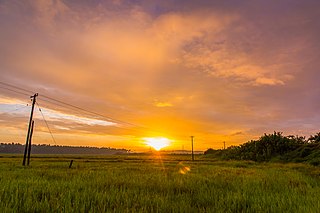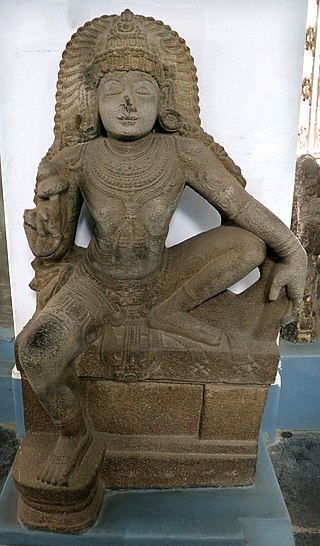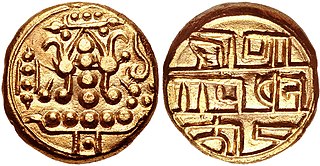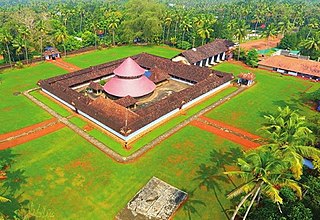Venad was a medieval kingdom between the Western Ghat mountains of India with its capital at city of Quilon. It was one of the major principalities of Kerala, along with kingdoms of Kolathunadu, Zamorin, and Kochi in medieval and early modern period.

The Chera dynasty, was a Sangam age Tamil dynasty which unified various regions of the western coast and western ghats in southern India to form the early Chera empire. The dynasty, known as one of the Three Crowned Kings of Tamilakam alongside the Chola and Pandya, has been documented as early as the 4th to 3rd centuries BCE. Their governance extended over diverse territories until the 12th century CE.

Ezhimala, a hill reaching a height of 286 metres (938 ft), is located near Payyanur, in Kannur district of Kerala, South India. It is a part of a conspicuous and isolated cluster of hills, forming a promontory, 38 km (24 mi) north of Kannur (Cannanore). The Indian Naval Academy at Ezhimala is Asia's largest, and the world's third-largest, naval academy.

The term Kerala was first epigraphically recorded as Cheras (Keralaputra) in a 3rd-century BCE rock inscription by the Mauryan emperor Ashoka of Magadha. It was mentioned as one of four independent kingdoms in southern India during Ashoka's time, the others being the Cholas, Pandyas and Satyaputras. The Cheras transformed Kerala into an international trade centre by establishing trade relations across the Arabian Sea with all major Mediterranean and Red Sea ports as well those of Eastern Africa and the Far East. The dominion of Cheras was located in one of the key routes of the ancient Indian Ocean trade. The early Cheras collapsed after repeated attacks from the neighboring Cholas and Rashtrakutas.

Thrissur, anglicised as Trichur, is one of the 14 districts in the Indian state of Kerala. It is situated in the central region of the state. Spanning an area of about 3,032 km2 (1,171 sq mi), the district is home to over 9% of Kerala's population.

Mushika dynasty, also spelled Mushaka, was a minor dynastic power that held sway over the region in and around Mount Ezhi (Ezhimala) in present-day North Malabar, Kerala, India. The country of the Mushikas, ruled by an ancient lineage of the Hehaya clan of the same name, appears in early historic (pre-Pallava) south India The dynasty claimed descent from the legendary Heheyas. Early Tamil poems contain several references to the exploits of Nannan of Ezhimalai. Nannan was known as a great enemy of the pre-Pallava Chera chieftains. The clan also had matrimonial alliances with the Chera, Pandya and Chola chieftains. The Kolathunadu (Kannur) Kingdom, which was the descendant of Mushika dynasty, at the peak of its power, reportedly extended from Netravati River (Mangalore) in the north to Korapuzha (Kozhikode) in the south with Arabian Sea on the west and Kodagu hills on the eastern boundary, also including the isolated islands of Lakshadweep in the Arabian Sea.

Aiyanar is a Dravidian folk deity venerated in South India and Sri Lanka. His worship is prevalent amongst rural Tamil people. Some studies suggest that Ayyanar may have also been worshipped in Southeast Asian countries in the past. He is primarily worshipped as one of the village deities of Tamil Nadu. Temples to Aiyanar in the countryside are usually flanked by gigantic colourful statues of him and his companions riding horses or elephants.

The Alupa dynasty was an Indian Hindu dynasty that ruled from 200 to 1444 A.D. in Southern India. The kingdom they ruled was known as Alvakheda Arusasira and its territory spanned the coastal districts of the modern Indian state known as Karnataka.

Ay was an ancient Indian dynasty which controlled the south-western tip of the Indian peninsula, from the early historic period up to the medieval period.The clan traditionally held sway over the port of Vizhinjam, the fertile region of Nanjinad, and southern parts of the spice-producing Western Ghat mountains. The dynasty was also known as Kupaka in medieval period.
Indian copper plate inscriptions are legal records engraved on copper plates. The practice was widespread and long-running in the Indian subcontinent; it may date back to as early as the 3rd millennium BCE, however the vast majority of recovered plates were produced in the 1st millennium CE. The plates were legal documents which registered and recorded an act of endowment, i.e. a grant or donation, typically of land or concessions. The plate contained bureaucratic information on land tenure and taxation essential to the operation of the state.

Religion in Kerala is diverse. According to 2011 census of India figures, 54.73% of Kerala's population are Hindus, 26.56% are Muslims, 18.38% are Christians, and the remaining 0.33% follow other religions or have no religion.

Vazhappally Maha Siva Temple is a Hindu temple located in Vazhappally near Changanassery in Kottayam district in the Indian state of Kerala. The temple is administered by the Travancore Devaswom Board. The temple is believed to be constructed by the first Chera king of Kodungallur. The legends suggest that the installation of the idol of god Mahadeva (Shiva) was performed by Parasurama himself. This temple is one among the 108 Shiva temples established by Parasurama. It is one of the few temples in Kerala where two nalambalams and two flag-masts are dedicated. The temple, a Grama Kshetra, also contains some seventeenth century wood carvings depicting figurines from epics. A Vattezhuttu inscription on the northern part of the base of the cultural shrine indicates that the repairs were completed in Kollam Era 840 (1665 CE).

The Malabar Coast is the southwestern region of the Indian subcontinent. It generally refers to the western coastline of India stretching from Konkan to Kanyakumari. Geographically, it comprises one of the wettest regions of the subcontinent, which includes the Kanara region of Karnataka, all of Kerala and Kanyakumari region of Tamil Nadu.

Buddhism amongst the Tamils was historically found in the Tamilakam region of India and Sri Lanka.

Ravivarman, styled Maharaja Ravivarman, Kulasekhara was the ruler of Venatu, with capital at port Kolambam (Quilon), southern India between 1299 – 1316/7. He – in all likelihood – was a descendant of the ancient Cheras. and was the son-in-law of the Pandya ruler of Maravarman Kulasekhara. Ravivarman raided large parts of southern India in a short period by skillfully taking advantage of the weakening of the Pandya kingdom and the confusion prevailed after the Khalji raids (1311).

Kandiyoor Sree Mahadeva Temple is an ancient Shiva temple situated in Kandiyoor near Mavelikkara on the banks of Achankovil river. Kandiyoor was once the capital of the Odanadu kingdom. The temple and region are related to the history of ancient Buddhism in Kerala. Mattom Sree Mahadeva Temple also known as shiva nada is 1 kilometre (0.62 mi) west of Mavelikkara town north of State Highway 6. It is spread across an area of 7.5 acres (3.0 ha).

Vikramaditya —better known as Vikramaditya "Varaguna"—was a monarch of the Ay dynasty of Kerala, south India. His surname indicates that he was a vassal or feudatory of the Pandya ruler Varaguna II. He was the immediate successor of Karunantatakkan "Srivallabha", a vassal of Pandya king Srimara Srivallabha.

Quilon or Coulão, officially Kollam, is one of the ancient civilizations in India. It is one of the oldest port cities in the Malabar Coast and was the capital city of historic Venad Kingdom and Travancore Kingdom. Quilon was once an important trading port in India. It was also known as Desinganadu. It is now known as the "Cashew Capital of the World".
This is a list of Buddhist sites, relics, and traditions in the Indian state of Kerala. Some historians states that Kerala had considerable Buddhist presence until the 16th century. Over the years, their population has drastically declined. According to the 1981 census, there were 223 Buddhists compared to 605 in 1971 census.

Avittathur Mahadeva Temple, an ancient Hindu temple dedicated to Lord Shiva is situated at Avittathur village of Thrissur District in Kerala state in India. Avittathur gramam (village) is one of the 64 original Brahmin settlements in the ancient Kerala. The Avittathur temple as well as Avittathur Gramam is equally famous like Thaliparamb gramam, Sukapuram gramam, Irinjalakuda gramam and Peruvanam gramam. Avittathur Mahadeva Temple is more than 2000 years old and four old inscriptions have been discovered. According to folklore, sage Agastya has installed the idol of Lord Shiva. It is also believed that the temple's shiva lingam was installed by lord Parasurama the sixth incarnation of Lord Maha Vishnu. The temple is a part of the famous 108 Shiva temples of Kerala.
















